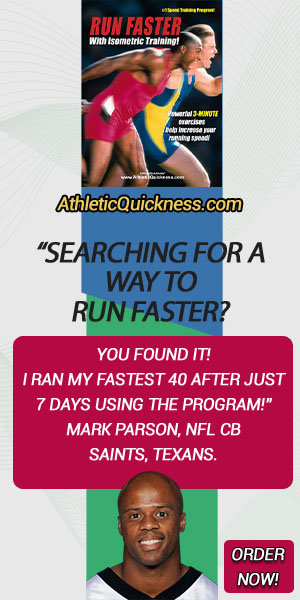Strong Hip Abductors Will Help You Increase Your Lateral Mobility
Lateral mobility is defined as the ability to move sideways either to the left or to the right. This lateral movement begins with the separation of one of your legs away from the other as seen by the athlete’s right leg in the figure above. The muscles responsible for this action are the hip abductors.
Having strong hip abductors will enable you to be more successful in any sport where quicker and faster lateral mobility is needed. This is because they will allow you to gain a more dominant position over your opponent and make a better play than them.
Lateral Mobility Needed For Almost All Sports
There are certain times in practically all sports where lateral mobility is required by an athlete. It can be needed while playing defense in basketball, soccer and football as well as offense. Good side-to-side movements are also needed to be successful in tennis when chasing after a ball as well as baseball. There’s rarely a time in a sporting event where lateral mobility isn’t needed.
The hip abductors are a very powerful group of muscles. Sometimes they only have to move the weight of the leg that’s in the air, such as the right leg in the image above. This is the easy part.
However, in sports, this movement is usually accompanied by the other leg aggressively pushing against the ground to separate it from the midline as well, just in the opposite direction. So, while both legs are needed to separate from the midline to create the lateral mobility you desire, the one firmly planted on the ground is doing the most work.
The Hip Abductors
The names of the hip abductor muscles are: 1) Gluteus Maximus, 2) Gluteus Medius, 3) Gluteus Minimus, and 4) Tensor Fascia Lata. There are located on each side of the body and can be seen in Figure 1 below:

Figure 1. The Hip Abductor Muscles.
Exercises to Increase Lateral Mobility
When it comes to exercising your hip abductors, the go to exercise for many is the hip abductor machine. This is an amazing piece of equipment that if you ever get a chance to use, then do so. However, all is not lost if you find yourself in a gym without one, or have no gym to go to at all. Resistance bands are plenty capable of challenging your hip abductors so that you can begin to increase your lateral mobility and one of the best strategies to use is an isometric training one that is offered here on this site.
Innervation, or, Nerve Supply to the Hip Abductors
The nerve supply to the abductor muscles is as follows: The Gluteus Maximus is supplied by the Inferior Gluteal Nerve and branches from the Sacral Plexus. The Gluteus Medius, Gluteus Minimus, and Tensor Fascia Lata are supplied by the Superior Gluteal Nerve. See Figure 2 below:

Figure 2. Nerves of the Abductor Muscles.
Superior Gluteal Nerve (L4, L5, and S1): Gluteus Medius, Gluteus Minimus, and Tensor Fascia Lata.
Inferior gluteal nerve (L5, S1, and S2): Gluteus Maximus.
Antagonist Muscles of the Hip Abductors
The muscle group that works opposite the hip abductors are the hip adductors. Ideally, if you are looking to increase lateral quickness then you will need to make sure you strengthen both of these muscle groups since an imbalance between the two could not only lead to reduced athletic performance, but also, injury.






